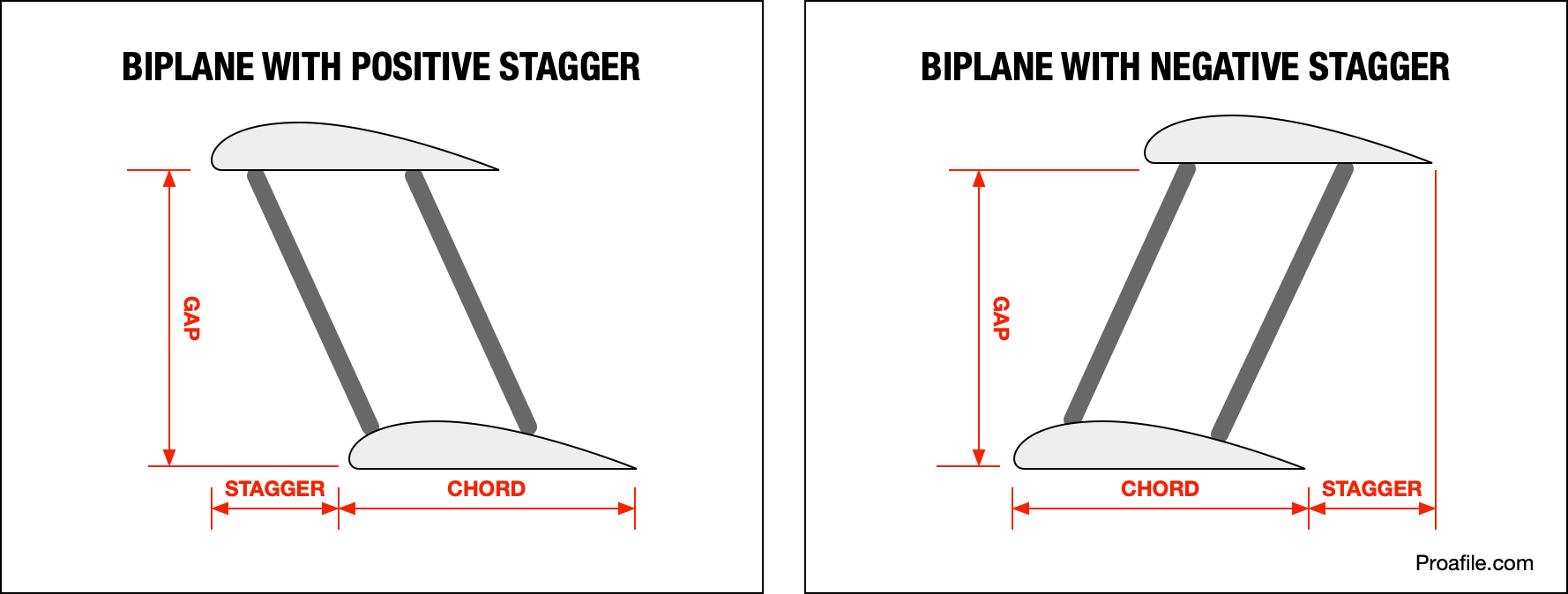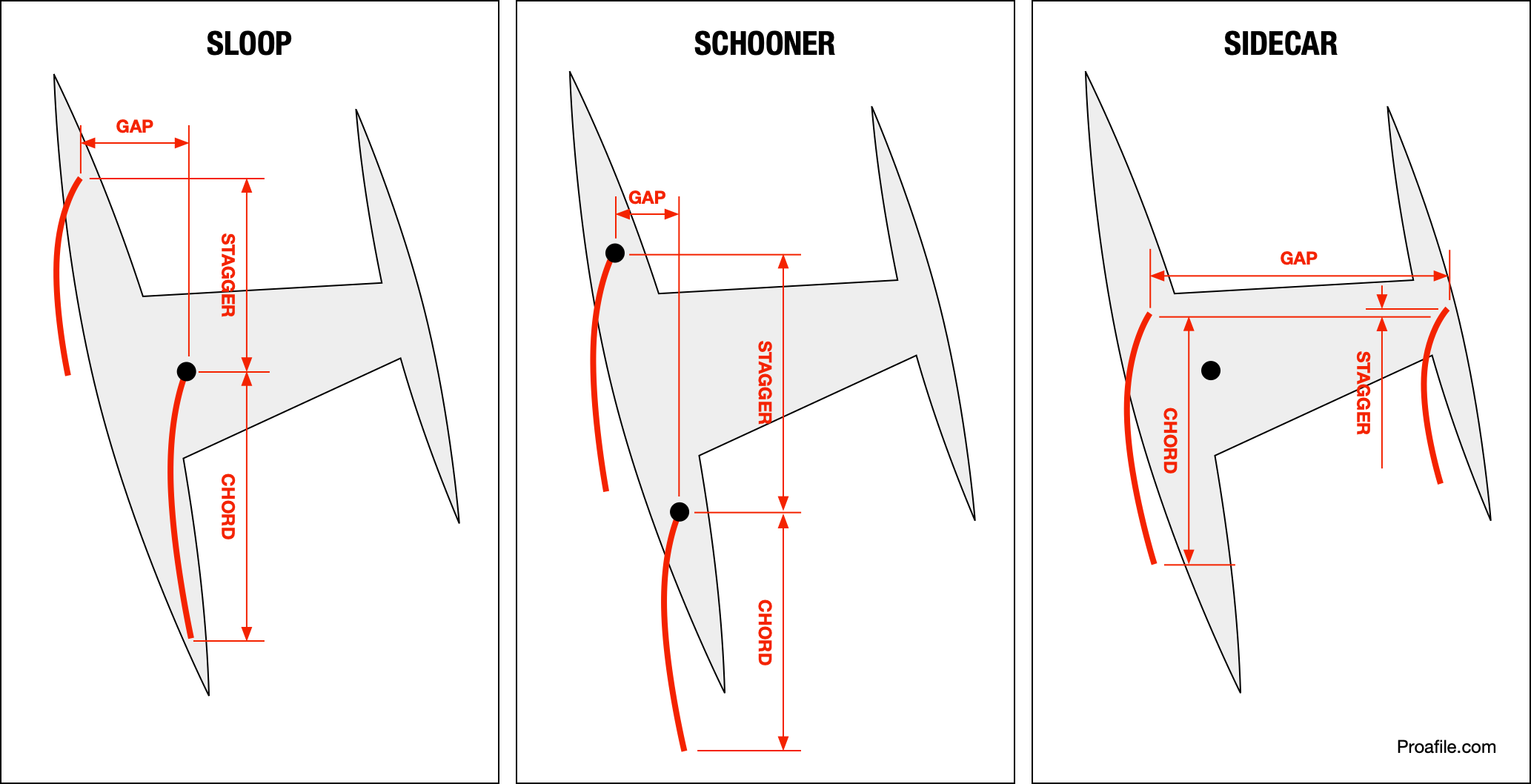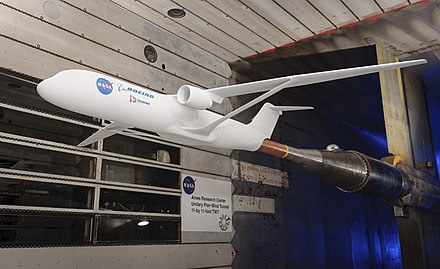Proa Rig Options: the Biplane
I’ve asked Robert Zabukovec to contribute to the Proa Rig Options section on Proafile with an article on the biplane rig he invented for SIDECAR. I’ve long been fascinated by biplane rigs, however my interest has always been limited to catamarans, not proas. Who knew? Robert’s thinking on the subject exploits the lateral asymmetry of the proa to advantage, creating a rig that is not only fast and easy to shunt, but also remarkably efficient.
But first, Rob’s disclaimer: “I am no aerodynamicist and have no access to CFD or XFoil or model/empirical testing. It is mostly gut feel and intuition. A classic situation of a little knowledge being dangerous!”
Biplane Aircraft
There are any number of wind tunnel studies which demonstrate that a monoplane is more efficient than a biplane for the same overall wing area. Principally because of less pressure differential between the two adjacent wing surfaces and because a monoplane has only two wing tip drag losses with each half wing fuselage end-plated. Whereas a biplane has four wing tip drag losses and only each half of the lower wing (ie only half the overall wing area) fuselage end-plated.
 Biplane basics
Biplane basics
The same studies also show that there is unequal lift distribution between biplane wings of equal area. The upper wing produces somewhat more, whist the lower wing produces significantly less, despite having fuselage endplates.
We all can see this effect on the water as well, two similar or one design boats sailing close to each other upwind, the leeward one (upper wing) always has the advantage on the windward boat (lower wing). How much depends on the distance between the two and the relative (stagger) angle between them. If the leeward boat is too far aft of abeam, there is no effect, actually slower because of the disturbed and deflected wind shadow of the windward boat. Too far forward of the windward boat, and the effect disappears.
At the end of the biplane era, aircraft designers optimized this by making the top wing larger and the lower wing as small as possible, minimizing its lift loss whilst still providing lift benefit to the larger upper wing. These planes were called sesquiplanes, and were recognized as being the fastest/most efficient of the time. There are other modifying factors, some are explained later.
 Left: Nieuport Delage NiD 44 Right: Nieuport-Delage NiD 52
Left: Nieuport Delage NiD 44 Right: Nieuport-Delage NiD 52
Differences Between Sails and Aircraft Wings
But perhaps a pair of yacht sails interacting together behave differently? Each sail is not identical in size, plan form or chord characteristics, the angle and distance between them usually varies, some converge to almost touching at the heads and most importantly, because they operate vertically, they experience different airflow strength and direction top to bottom along their length, whereas in aviation, they operate horizontally in pretty much constant airflow strength and direction for their entire length. Most sailing rigs have a significant amount of twist along their length (ie height), you don’t see any twist in aircraft rigs. And perhaps because of all this, there are some, who should know, like North Sails, say that two sails, working in combination will produce more lift than the same two sails completely separately.
“If the jib and main are working as seperate elements and not as one wing, that again reduces the efficiency and increases the drag of the whole package.”
— Julian Bethwaite, 1 February 2023. Post 898
Certainly, two sails generally have more luff length and therefore greater “beneficial” drive for the same area than a monoplane/una rig. If a jib sheds its head vortex into the upper mainsail, then there is ultimately only one tip vortex for the two sail combination. Plus directing additional air towards the upper mainsail, which operates in freer, stronger and steadier airflow.
Biplane Rig Types
All two-sailed rigs are biplanes, but with differing characteristics depending on the stagger or relationship to each other, the distance between them, their sail area distribution and profile.

Upwind, Sloop rigs have a large (positive) stagger angle. Fore and aft schooner rigs have the largest positive stagger angle but the narrowest gap, with an adverse effect on lift due to shadowing on the aft sail. Perhaps, because of this, it is a large negative stagger angle? Again, on the water, you would never choose to sail close behind another boat.
Sloop rigs, are also mostly sesqui rigs, in that their sail areas aren’t equal in distribution or profile. But they have it the wrong way round, the jib (upper wing) being smaller than the mainsail (lower wing).
The angles of attack upwind (AoA) on a sloop rig are fairly fixed, the (smaller) foresail being ~10-15 degrees from boat centreline, with the (larger) mainsail being ~0-5 degrees. With a biplane rig, the respective AoA’s are not so interdependent. On Sidecar, (light wind- medium wind) the jib is ~15-10 degrees and the mainsail is ~10-15 degrees. So the larger sail benefits from a more favourable sheeting angle for the same apparent wind angle, as well as the gain of being the “upper wing”.
Sidecar’s rig has virtually no stagger, a wide gap, and is a true sesqui, that is, it has a larger leeward (upper wing) mainsail and a smaller windward (lower wing) jib and therefore should derive greater beneficial interaction. On a sloop rig, the smaller jib is usually end-plated, on Sidecar it is the larger mainsail which perhaps could further increase any theoretical gain.
As these rigs come off the wind, the stagger angle reduces, until the stagger is sufficiently negative for there to be lift loss due to shadowing. A fore and aft schooner rig improves lift initially (due to reducing aft sail shadowing) and then loses lift again later. Sidecar’s rig loses sesqui benefit soonest, due to less stagger, but unlike the others, there comes a point, where, sufficiently off the wind, the rig regains positive stagger (ie when at least the upper leech of the jib is to leeward of the mainsail) and behaves like a sloop rig upwind. All side by side biplane schooner rigs have this similar characteristic.
Sidecar’s area distribution and profile of windward jib and leeward mainsail couldn’t possibly be optimal on first try. I can now see how to also end plate the windward jib. The area distribution and stagger between the two sails could be improved. There still is a lot still to play around with because I am dealing with two entirely different sails, with variable positioning, not identical ones on masts fixed side by side.
It really needs a methodical study, using CFD or Xfoil on many options, but that is beyond my pay grade and ability.
Notes
Any sloop or conventional schooner rig on a multihull with sufficient weather shroud angle can be “adapted” to a biplane rig when conditions suit. Use or borrow an old jib of appropriate geometry, and tack it somewhere near the front cross beam, sheeted somehow off the aft cross beam. More sail area for very little increase in heeling moment, and possibly some biplane/sesqui effect, especially on long legs. Cumbersome to tack and gybe though.
As an aside, another interesting possibility is an overlapping schooner rig. The conventional schooner rig isn’t particularly efficient upwind, for the reasons given earlier, but if there was sufficient overlap between the two (because you can on a proa) perhaps you can make the two mainsails interact in a more beneficial way? You would also get some pitching benefit, because the two masts would be more central, and out of the ends. But you would still have a proa shunting problem in that when shortening sail, you would have to shorten both, otherwise you would be hoisting one and shortening the other with each shunt.”
And finally, tongue in cheek, roll this recent experimental jet plane through 90 degrees, and you almost have two mirrored Sidecar rigs:

Links
Sesquiplanes
Boeing Truss-Braced Wing
North Sails Blue Paper: How Sails Work
Biplane and Triplane Wing Lift and Efficiency





I really appreciate Robert taking us through the aerodynamics of his
rig, which is so unusual it’s hard to envisage how the sheeting and
staying work. The only other person doing anything like this is I
think Fritz Roth. Robert how do you sheet and vang this windward
jib, given how little boat there is to ww of it to sheet to? Can it reef, or
what do you do with it in strong wind? I can see its location is
beneficial to balancing the weather helm.
I’m building a 24ft dayboat proa with two lug rigs fairly widely
separated. Model tests at 1/8 scale do indicate that the forward sail is
sailing in free-er air and developing more lift than the aft one, which
help with the weather helm. I hope, but have no way of knowing, that
the front sail’s performance is being improved by the aft sail more
than the aft sail is being impaired by the front one, as the North
article might suggest.
Russell Brown puts the windward ability of his proas down in part to
the wide gap between the jib and the main which a proa allows, by
siting the mast to ww of the centreline. Your rig has an even bigger
gap which the biplane/triplane article says improves efficiency. In a
sesquiplane is the gap/chord ratio worked out with the chord of the
main plane or the half plane?
You show a dotted outline of a reacher set on an extension of the jib
boom; how does that affect the performance and balance? Sidecar is
such a great boat, I wish I had been able to visit you when we rowed
past on the Tawe Nunnugah 2019!